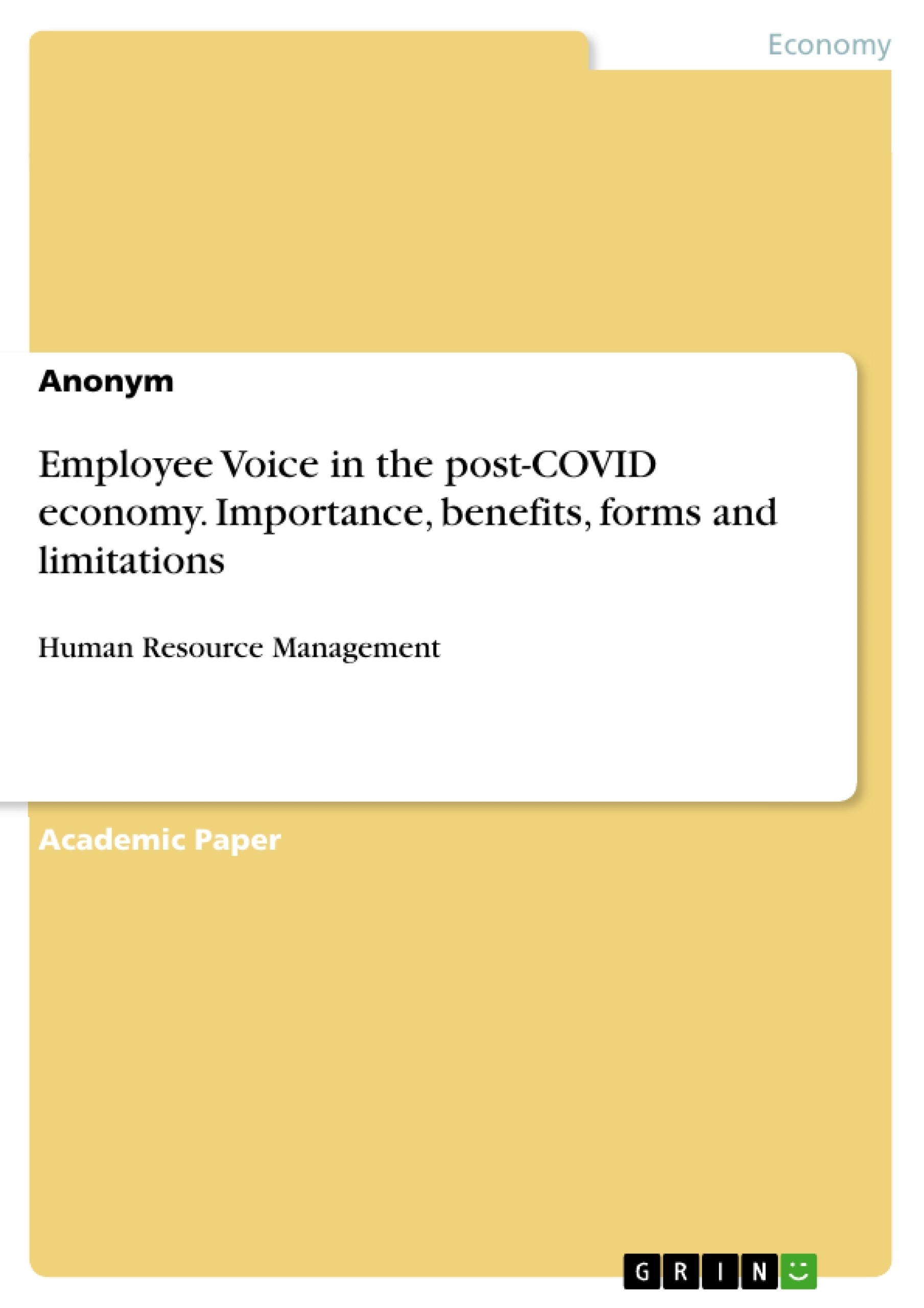This essay critically examines the meaning and importance of employee voice in the post-COVID economy. The essay considers the meaning, importance, benefits, forms and limitations of employee voice. It demonstrated the influence of COVID-19 on employee voice and relationship, indicating how organizational productivity was also affected. Employee voice can be described as “the voice of employees being heard, the participation of employees and taking into consideration the views of employees”.
Employee voice may come in different formats; employees expressing their grievances, employee playing a part in the trade union while being involved in the process of negotiation as part of a collective bargaining process, employees taking decision making processes etc. While the concept itself can be ambiguous, its nature is defined by the kind of organization and cultures upon which such an organization is founded. As a result, it is most popular in organizations without a hierarchical structure, except in the rare occasion of industrial relations in which trade unions are heavily involved in employee voicing process. Decision making processes are now evolving to adopt more participative styles, which includes employee inputs.
Inhaltsverzeichnis (Table of Contents)
- Introduction
- Meaning and Importance of Employee Voice
- Importance of Voice of Employee
- Forms and Methods of Employee Voice
- Trade Union
- Staff Forum, consultation and information committees
- Staff Survey
- Direct Approach
- Evaluation of Unitary and Pluralistic Frames of Reference in Employee Relations and Employee Voice
- Unitary Perspective
- Pluralist Perspective
- Benefits of Employee Voice
- Limitations of Employee Voice
- Impacts of COVID-19 on Employee Voice and the Impact for Employee Relations
- Physical Distancing
- Weak Economy
- Conclusion
Zielsetzung und Themenschwerpunkte (Objectives and Key Themes)
This essay examines the significance of employee voice in the post-COVID economic landscape. It explores the meaning, importance, benefits, forms, and limitations of employee voice, while also analyzing the influence of COVID-19 on employee voice and relationships, and how these factors have affected organizational productivity.
- The definition and importance of employee voice
- Various forms and methods of employee voice
- The unitary and pluralistic perspectives on employee relations and voice
- The impact of COVID-19 on employee voice and employee relations
- The benefits and limitations of employee voice
Zusammenfassung der Kapitel (Chapter Summaries)
The essay begins by defining employee voice and emphasizing its significance in organizational settings. It discusses how employee voice can manifest in various formats, including expressing grievances, participating in trade unions, engaging in collective bargaining processes, and contributing to decision-making.
The essay then delves into the importance of employee voice, highlighting its role in improving customer operations by gathering insights from employees who directly interact with customers. Employee voice programs can help organizations understand and address customer expectations and satisfaction levels. This section also emphasizes the importance of employee voice in identifying training needs and providing updates to leaders on organizational developments, ultimately fostering improved employee experience and retention.
The essay continues by examining different forms and methods of employee voice, including traditional models like trade unions, staff forums, consultation and information committees, and informal bodies. It also explores newer forms like staff surveys and direct approaches, acknowledging both their potential benefits and limitations.
The essay then evaluates the unitary and pluralistic frames of reference in employee relations and employee voice. The unitary perspective emphasizes a harmonious and integrated organization where management and employees share common goals and interests. This perspective views conflict as disruptive and unnecessary, often leading to the rejection of trade unions. The pluralistic perspective, on the other hand, acknowledges the existence of different interests and perspectives within organizations, recognizing the potential for conflict and the need for mechanisms like trade unions to represent employee voices.
The essay further explores the benefits of employee voice, acknowledging its contribution to improved employee morale, increased productivity, and enhanced organizational performance. It also examines the limitations of employee voice, highlighting potential challenges like power imbalances, lack of employee trust, and the possibility of manipulation by management.
Finally, the essay examines the impact of COVID-19 on employee voice and employee relations. It explores how the pandemic has led to increased reliance on remote communication, potential disruptions to traditional voice mechanisms, and the need for organizations to adapt to a changing work environment.
Schlüsselwörter (Keywords)
The key concepts and themes explored in this essay include employee voice, employee relations, organizational culture, trade unions, unitary and pluralistic perspectives, COVID-19, employee experience, customer experience, training needs, and leadership development. The essay delves into the significance of employee voice in modern organizations, exploring its various forms, benefits, and limitations, and examining the impact of the COVID-19 pandemic on this critical aspect of workplace dynamics.
- Quote paper
- Anonym (Author), 2021, Employee Voice in the post-COVID economy. Importance, benefits, forms and limitations, Munich, GRIN Verlag, https://www.grin.com/document/1145710




